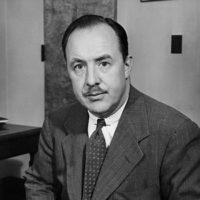
Thomas Francis, Jr
University of Michigan
For contributions to our knowledge of influenza, and the development of a vaccine effective against Types A and B, successfully used during World War II. Read about the achievement
Dr. Francis's researches on influenza began about two decades ago. In 1928, he joined the staff of the hospital of the Rockefeller Institute, and in 1936 he organized for the International Health Division of the Rockefeller Foundation the influenza study laboratories where pioneer work was done on the etiology and epidemiology of the disease. In 1938, he became professor of bacteriology at New York University, and in 1941 he accepted the professorship of epidemiology and chairmanship of the Department of Epidemiology in the newly established School of Public Health at the University of Michigan. In 1947, Dr. Francis was appointed to a distinguished professorship at Michigan, known as the Henry Sewell Professorship of Epidemiology.
Dr. Francis's contributions to scientific literature have been numerous and have brought him many honors. Since the first report in 1934 on the recovery of the virus of influenza A in the Western Hemisphere, which confirmed the primary observation of Smith, Andrewes and Laidlaw, Dr. Francis's studies have included a series of immunological, epidemiological and clinical observations directed toward a better understanding of the human disease. The demonstration with Magill of serological variations in strains has resulted in sustained studies of its significance in recurrent epidemics. The identification of influenza B and isolation of that virus added clarification to the problem by establishing a new entity in a complex field. His continuous investigations have contributed much to our knowledge of the global aspects of the disease.
Studies of the selective action of influenza virus on the respiratory epithelium and of antibodies in the respiratory secretions have given insight into the mechanisms of infection and immunity. From the original demonstration in 1936 that influenza virus given subcutaneously or intradermally could induce the formation of antibodies in man, successive studies have brought evidence in controlled observations of the effectiveness of human immunization against influenza.
As director of the Commission on Influenza of the Army Epidemiological Board, Dr. Francis organized and actively participated in the establishment of "listening posts" for the detection of influenza in various parts of the US, and in the Army studies which gave evidence that vaccination can be effective against epidemic influenza A and influenza B.
Thus Dr. Francis, through his own contributions and through his stimulation of other investigators, has made a notable contribution to our knowledge of influenza which affords a sound foundation for future work, and has created the hope that this disease may eventually be conquered.
Were an epidemic of an unknown influenza type to occur in the proportions of that which followed World War I, claiming 20 million lives, science could now produce a vaccine to successfully control its spread. Responsible for the identification of influenza B, one of the two known types, and for the isolation of that virus, Dr. Francis helped develop a vaccine effective against both A and B, successfully used during World War II. Lengthy studies by him have resulted in new knowledge of the symptoms of the disease and the manner of its contagion. He has established a sound foundation for future work aimed at the eventual conquest of the wholesale destroyer—influenza.
